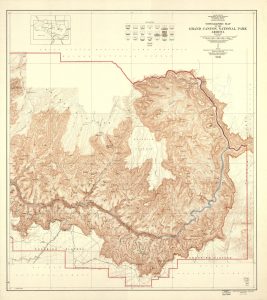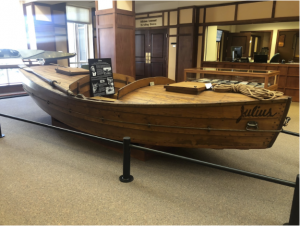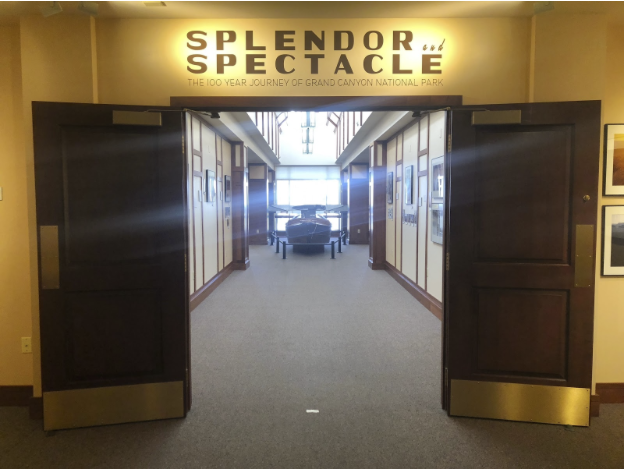Jan. 29, 2018
It’s kind of a big deal.
One might even say it’s grand.
On Feb. 26, 1919, Woodrow Wilson signed the Grand Canyon National Park Act. Nearly 100 years and millions of visitors later, the Grand Canyon is one of the nation’s largest, most recognized national parks.
In celebration of the coming centennial, the Special Collections and Archives at Northern Arizona University’s Cline Library has produced an exhibit dedicated to the oversight and management of the park, displaying many pieces from the canyon’s and region’s history to educate and excite visitors. “Splendor and Spectacle: The 100-year journey of the Grand Canyon National Park” brings together a collection that, through key themes such as exploration, science, tourism, recreation, the built environment and more, tells the story of Arizona’s greatest treasure.
“For this exhibit, we worked closely with colleagues from the Grand Canyon National Park and Arizona State University Libraries to secure a $33,000 grant to digitize content from our collections,” said Peter Runge, head of Special Collections and Archives. “We digitized over 3,000 items from our respective collections dating from 1890-1940 that documented the four eras: exploration, free enterprise, early federal oversight and the first 21 years as a national park.”
Each year, the Special Collections and Archives team installs one major exhibit, with themes developed three to five years prior to installation. Stemming from a meeting in 2014, planning for “Splendor and Spectacle” began in fall 2017. The exhibit is an outgrowth of a student internship opportunity, the Elizabeth M. and PT Reilly internship.

National Parks Map Collection, NAU.MAP.101.1
“The Reilly internship allows us to spend 10 weeks with a student to provide them with an intensive learn-by-doing experience,” Runge said. “The entire department works with the intern to help them learn pragmatic skills such as project management, story development, intensive research, donor relations and exhibit fabrication, as well as exercising their creativity.”
Senior Hana Lipke, studio art and comparative cultural studies major, was the 2018 Reilly intern; she helped complete the Grand Canyon and Colorado Plateau project. Standing in the exhibit that was years in the making, she explained the immense amount of mentorship she received from the staff and the opportunity to use her creative abilities on a physical project. For 10 weeks during summer 2018, Lipke outlined the story, selected content and developed the online exhibit. After her work, the department could begin building and installing the displays.
“The Special Collections and Archives advertised the position and created the theme for the year,” Lipke said. “From then on I basically had full creative control—I picked the images, I built the website, I wrote the text. The staff in Special Collections and Archives guided the narrative and oversaw my work. They provided edits and made my vision a reality. By and large, though, I was able to create the whole exhibit with just the basic theme given.”
The majority of the content housed in the upstairs room of Cline Library comes from the collections of the department. Visitors will see cases of memorabilia, including artifacts like posters and documents from different eras, and a large monitor to search the depths of the online version of the exhibit. Through historical artifacts such as maps, photographs, travel tickets and letters, films, oral histories and more, those wandering through can get lost in the history of the Grand Canyon. Also on display are two historic boat replicas, one from the Grand Canyon National Park Museum and the other loaned by Brad Dimock, a local river runner who handcrafted his contribution to the exhibit. Dimock’s boat is replica of Julius, which Buzz Holmstrom built for a solo trip up and down the Green and Colorado rivers, which he did in 52 days.
“I couldn’t be more pleased with the outcome,” Lipke said. “The team in Special Collections brought my ideas to fruition, and I cannot believe I am able to attach my name to such an amazing exhibit. This is an incredible opportunity, especially for an undergraduate student. This has been the highlight of my undergraduate career and I am so ecstatic with the results, both digitally and physically.”
Lipke also said the exhibit differs from others in terms of its contents; it is meant to paint as complete of a picture as possible of the canyon and its history. By having both a physical and digital experience for visitors, there was room for emphasis on certain areas when developing the physical exhibit.
“We did our best to include a range of both textual and visual sources from a wide range of dates and sources,” she said. “Generally speaking, this exhibit was meant to provide as comprehensive of a view as possible, with as few items as possible. From there, subcategories were built and it became more about connecting information to each other and to the central narrative than about finding items in general.”

Kathleen Schmand, director of development and communications at Cline Library, said the team hopes the lack of “things” generally found in other types of museum exhibits highlights the importance of those items the exhibit does include and drives visitors to seek out more information on the Grand Canyon.
“This exhibit carves a path to discussion and awareness of the renowned collections housed in the department,” she said. “Special Collections and Archives has worked diligently to become one of the premier archival repositories collecting the history and culture of the region. We have hundreds of collections documenting a variety of areas of the human and natural history of the Colorado Plateau.”
The community created through these types of exhibits serves as a stepping stone into developing greater connections within NAU and research communities throughout the world. Events such as this serve as a gateway into the collections and offer opportunities to immerse oneself in the human and natural history of the Colorado Plateau and beyond.
“Everyone’s relationship with the Grand Canyon is different,” Runge said. “For some, it is an opportunity to see one of the seven natural wonders of the world; for others, it is their office; for others yet, it is an opportunity to immerse themselves in one of the most beautiful and rugged areas of the Southwest. We hope the exhibit provides something familiar that everyone can connect with.”
“Splendor and Spectacle” will be on display at the Cline Library, second floor, through September 2019. Hours for the Special Collections and Archives are Monday through Thursday 9 a.m. to 6 p.m. and Friday 9 a.m. to 5 p.m. For more information, visit the library’s website or call (928) 523-5551.

(928) 523-2282 | NAUComm@nau.edu



